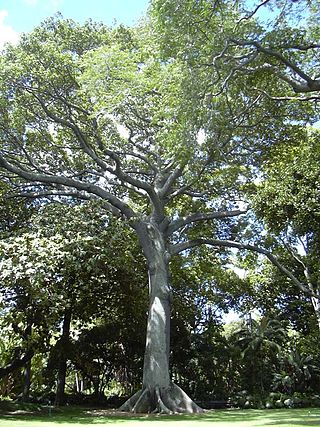
Ceiba pentandra is a tropical tree of the order Malvales and the family Malvaceae, native to Mexico, Central America and the Caribbean, northern South America, and West Africa. A somewhat smaller variety has been introduced to South and Southeast Asia, where it is cultivated.

Ceiba is a genus of trees in the family Malvaceae, native to tropical and subtropical areas of the Americas and tropical West Africa. Some species can grow to 70 m (230 ft) tall or more, with a straight, largely branchless trunk that culminates in a huge, spreading canopy, and buttress roots that can be taller than a grown person. The best-known, and most widely cultivated, species is Kapok, Ceiba pentandra, one of several trees known as kapok. Ceiba is a word from the Taíno language meaning "boat" because Taínos use the wood to build their dugout canoes.
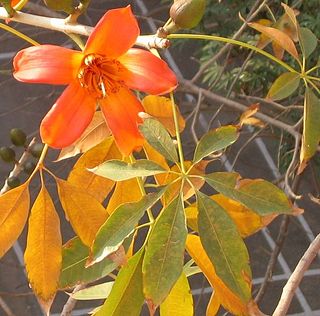
Bombacaceae were long recognised as a family of flowering plants or Angiospermae. The family name was based on the type genus Bombax. As is true for many botanical names, circumscription and status of the taxon has varied with taxonomic point of view, and currently the preference is to transfer most of the erstwhile family Bombacaceae to the subfamily Bombacoideae within the family Malvaceae in the order Malvales. The rest of the family were transferred to other taxa, notably the new family Durionaceae. Irrespective of current taxonomic status, many of the species originally included in the Bombacaceae are of considerable ecological, historical, horticultural, and economic importance, such as balsa, kapok, baobab and durian.

Bombax is a genus of mainly tropical trees in the mallow family. They are native to western Africa, the Indian subcontinent, Southeast Asia, and the subtropical regions of East Asia and northern Australia. It is distinguished from the genus Ceiba, which has whiter flowers.

Ceiba speciosa, the floss silk tree, is a species of deciduous tree that is native to the tropical and subtropical forests of South America. It has several local common names, such as palo borracho, or árbol del puente, samu'ũ, or paineira. In Bolivia, it is called toborochi, meaning "tree of refuge" or "sheltering tree". In the USA it often is called the silk floss tree. It belongs to the same family as the baobab; the species Bombax ceiba; and other kapok trees. Another tree of the same genus, Ceiba chodatii, is often referred to by the same common names.
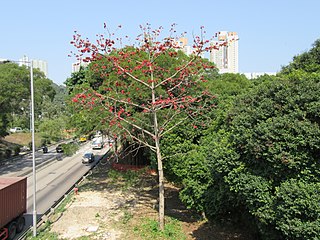
Bombax ceiba, like other trees of the genus Bombax, is commonly known as cotton tree. More specifically, it is sometimes known as Malabar silk-cotton tree; red silk-cotton; red cotton tree; or ambiguously as silk-cotton or kapok, both of which may also refer to Ceiba pentandra.

Kigelia is a genus of flowering plants in the family Bignoniaceae. The genus consists of only one species, Kigelia africana, which occurs throughout tropical Africa. The so-called sausage tree grows a poisonous fruit that is up to 60 cm long, weighs about 7 kg, and resembles a sausage in a casing.
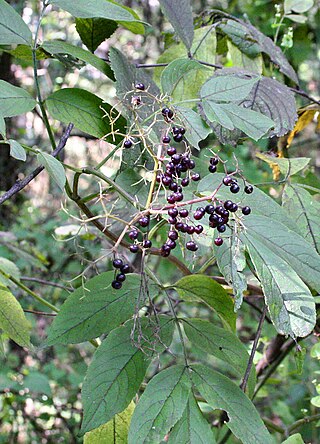
Sambucus canadensis, the American black elderberry, Canada elderberry, or common elderberry, is a species of elderberry native to a large area of North America east of the Rocky Mountains, south to Bolivia. It grows in a variety of conditions including both wet and dry soils, primarily in sunny locations.
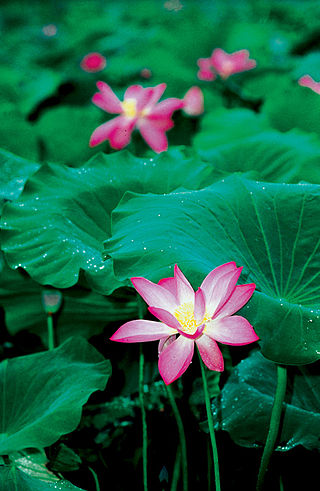
This is a list of plants commonly found in Kakadu National Park, Northern Territory of Australia. Where known, common names are given in English and in Gun-djeihmi, a commonly spoken indigenous language in the area, are given in parentheses.
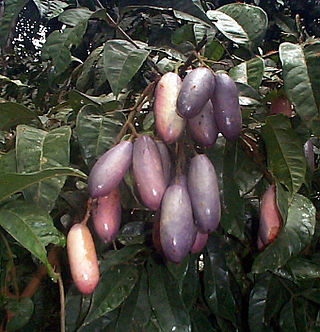
Dacryodes edulis is a fruit tree in the family Burseraceae native to Africa. Its various regional names include safou, messa, plum (Cameroon), atanga, ube, elumi (Nigeria), African pear, bush pear, African plum, nsafu, bush butter tree, or butterfruit.
Kapok fibre is a cotton-like plant fibre obtained from the seed pods of a number of trees in the Malvaceae family, which is used for stuffing mattresses and pillows, for padding and cushioning, and as insulation.
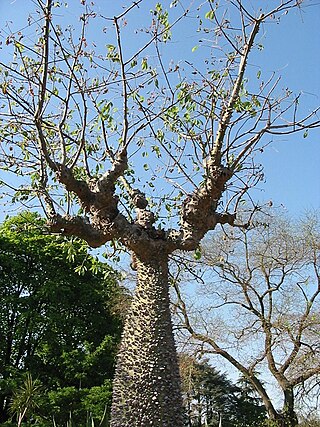
Ceiba chodatii, the floss silk tree, is a species of deciduous tree native to the tropical and subtropical forests of South America. It has a bottle-shaped swollen trunk in which water is stored for the dry season and is known locally as palo borracho.
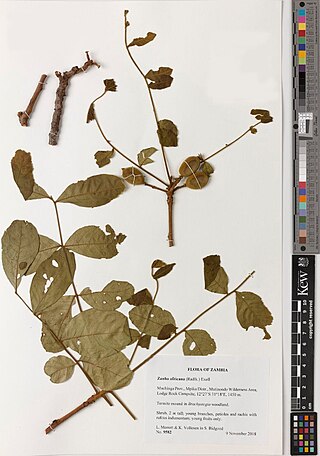
Zanha africana, commonly known as the velvet-fruited zanha in English and as mkalya or mkwanga in Swahili, is a species of plant in the family Sapindaceae that is native to Africa. It is used locally for timber and herbal medicine.

Sterculia foetida is a soft wooded tree that can grow up to 35 metres tall. Common names for the plant are the bastard poon tree, Java olive tree, hazel sterculia, wild almond tree, and skunk tree.
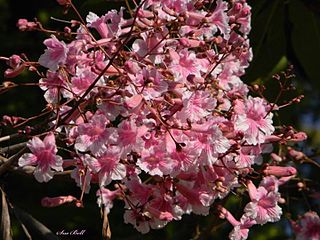
Stereospermum kunthianum is an African deciduous shrub or small tree occurring in the Democratic Republic of Congo, Djibouti, Eritrea, Ethiopia, Kenya, Malawi, Senegal, Somalia, Sudan, Tanzania and Uganda. It is widespread across Africa to the Red Sea, and reaches as far south as Angola, Mozambique, Zambia and Zimbabwe. There are some 30 species with a Central African and Asian distribution.
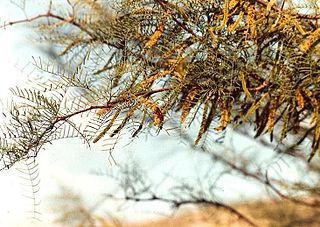
Prosopis chilensis is a species of tree in the genus Prosopis, belonging to the family Fabaceae. It is found in parts of central Chile, southern Peru, Bolivia, and Andean (northwestern) Argentina. Its common names include Chilean mesquite, cupesí, and Chilean algarrobo. It is used for providing shade, for animal feed, and firewood.

Dysdercus cingulatus is a species of true bug in the family Pyrrhocoridae, commonly known as the red cotton stainer. It is a serious pest of cotton crops, the adults and older nymphs feeding on the emerging bolls and the cotton seeds as they mature, transmitting cotton-staining fungi as they do so.
Balanites wilsoniana is a species of fruit-bearing tree from west and central Africa from the caltrop family (Zygophyllaceae).

Lannea welwitschii is a species of tree in the family Anacardiaceae. It is native to the tropical rainforests of West and Central Africa. The timber is used to make furniture and utensils and for many other purposes, the fruits can be eaten, and the bark is used to produce a dye, for making rope and in traditional medicine.

Barringtonia edulis is a species of tree with edible fruits from the southwestern Pacific region, being found on Fiji and Vanuatu. Common names include cut nut, pao nut, boxfruit tree, heart tree, and yum-yum tree.



















